Thursday May 8th - Wednesday, May 14th
This is the little motor home we rented for the next three weeks. We managed to get to our first caravan camp with no major mishaps. We had a little trouble trying to figure out how to connect with the road we wanted and went back and forth between a couple of roundabouts a few times. We only got honked at a couple of times, so that wasn't too bad. It was a standard transmission and it took John a little while to get used to it, so he killed it in traffic a few times, but that was all part of the fun. It was also diesel and we got about 25 miles per gallon, which was good, because gas figured out to about $6.00 a gallon. Ouch!
This is a very typical set-up that we saw at many campgrounds. The add-on tents are made to zip right onto the trailers and with the lean-to part on the far end are bigger than the trailer itself. They are very nice.
Getting set up, we found we did not have the right hose connection to hook up to water, so we walked a short ways into town to the garden center to get one. Good thing we brought "brollys" and rain jackets, as it did rain quite often. We walked to a nearby pub where John had a rump steak and a pint of ale. Dawn had the gammon (ham) steak with and egg and I had the gammon steak with pineapple. We shared a toffee pudding desert. The word pudding just refers to desert in general. It was a moist cake drizzled with warm custard. Oh, so good. Do not miss the deserts if you go!
Friday we took the city bus to Cambridge, only a couple miles away. We had lunch at the Eagle Pub where Francis Crick and James Watson first announced their discovery of how DNA carries genetic information in 1953. There has been a pub here since 1525. Scientists from Cavendish laboratories had been coming here for decades to relax and discuss theories. It was known as the Eagle and Child in 1667. The electron was also discovered at Cambridge in 1897, the basis of chemical bonding and electronics and computing.
We took an excellent two-hour guided walking tour around Cambridge from the Visitors Center. On the left, behind the Chestnut tree is King's Chapel, part of King's College, which was founded in 1441 by King Henry VI with 16 choristers and 10 chaplains to sing daily services. Today there are 16 boy choristers who come there at age eight and live there and are educated there. There are also 14 men and 2 organ scholars. They rehearse daily in the early morning and sing services in the chapel 5 days a week during the school term. They have a worldwide reputation and do a major overseas concert tour in the summers. They do a Christmas Eve program that has been broadcast live since 1928 and goes to 150 countries. It always starts with the same song and one of the young boys is chosen at the instant of broadcast to sing the solo, so all must be prepared. During university term worship is held daily according to order of the Church of England. They have many famous alumni, including Salman Rushdie and Alan Turing.
View inside King's Chapel. The divider across the center keeps the peasants in the back half of the church. In front of the divider is the ornate seating for the choristers on each side. They face each other while they sing the service. The organ pipes are above the divider. They have a 13th century Ruben's painting over the alter that they purchased in 1959 for 250,000 pounds. It is now worth over 50 million pounds ($85 million)! I think I got that right, but it's still hard for me to believe. When Cromwell was in charge, soldiers and horses were stabled in here from winter weather. They were supposed to destroy all the ornate stuff relating to Catholicism, but probably left the stained glass windows in order to stay warm and left in a hurry without destroying them. They were all removed during WWII to protect them and it took 3 years to replace them.
Next to King's Chapel, our guide pointed out the Senate building. He said students have a long-time reputation for climbing stunts and sometimes jump from the left corner of this building over to the corner of the one next to it. It's called the Senate Jump. There is an official club called the Midnight Club. They also dismantled an automobile and during the night hauled it to the top of the building on the left and put it back together. It took three days to get it back down and someone sent them a case of champaign anonymously, presumably a very impressed engineering fellow. Also the spires on the front of King's Chapel above have some sort of barb wire stuff around them to keep students from attempting to climb them. Whoa, I certainly hope there's no alcohol involved in these climbing stunts.
This is a peak inside Trinity College from the side entrance. The man with the bowler hat walking back and forth is supposed to be available to answer questions, but he is also there to keep tourists out and people off the grass. They are very particular about their grass at all of the colleges and no one is allowed to walk on it. Over the front entrance very high up, there is a statue of King Henry VIII holding a sceptor and orb. The sceptor was stolen and replaced with a chair leg. It became a sort of tradition, so they just left it holding a chair leg, which still gets repeatedly stolen and they just replace it with another chair leg. Cambridge University is very different than you would think. It is made up of 31 separate colleges (19,000 students) spread out all over the city. The students live and eat in the dining halls of their respective colleges. King's College, for instance, has 430 undergraduates, 250 graduates and 120 fellows (professors). That's about 1 teacher for every five students. Each student meets regularly with his or her fellow to discuss their courses and progress and gets assigned certain reading and lectures to attend throughout the university that relate to his or her field of study. Then they are required to write essays and have discussions with their fellow. Then they are required to attend and pass exams at a central university building wearing their graduation-style robes. They are not allowed to take the exams if they show up not wearing their robes. There are over 100 libraries in the University of Cambridge. We got a peak into several of the colleges, but most don't allow tours, King's, Trinity, Clare, Christ Church, Corpus Christi, St. John's, etc. Some parts of the Harry Potter movies were filmed here.
This is Honor's Gate.
This was inside a church that was the first ever completed project designed by Christopher Wren, who designed over 50 of the current churches (and many other buildings) in London after the Great Fire of 1666. On either side is the very plain seating for the choristers who faced each other. It was a gift to Pembroke College by his uncle who was a bishop and a fellow of the college. Christopher Wren was a professor of astronomy at Oxford at the time. Pembroke was the first college in the world to give a degree in music in 1463.
Our guide stopped us at number 3 Free School Lane. He told us a story about a gentleman who was visiting a lady at this address and she told him he should marry. He said, "No one would marry me." Alice jumped up from behind the sofa where she had been hiding and said, "I will, when I'm old enough." When she was older they did marry and moved to Australia where he was in charge of building a telegraph line. No water could be found in the center of the country and they thought they might have to give up. When they finally found water, the crew named the place after their boss's wife and called it Alice Springs.
View of King's College Chapel from the back, walking along the canal. We missed seeing it, but in a little church near King's Chapel, attended by Gilbert Washington (uncle of George Washington), is the family Coat of Arms, an eagle with red and white stripes and stars. Sound familiar?
Punting on the River Cam. You can hire a College "Backs" punt tour, if you don't want to do the work yourself. It looked like it could be a lot of work. These three sort of all ran into each other as they got nearer to us and had a little trouble getting sorted out.
Cambridge University Press, the longest, continuous operating book shop in in the world, since the 1580s. Opposite side of street is the first book printed by Cambridge University Press in an unbroken line of printing until 2013.
We had supper that evening at the Square and Compasses Pub about a miles walk from our campground.
Walking back to camp with a few groceries we picked up after supper. We spent two nights here.
Saturday we hit the road again. The M-6 motorway is very busy with four lanes going each direction. I think John was still a little tense.
I sure don't know why. "Have you got the change ready for the toll, Dawn?" I sure was glad to let Dawn be co-pilot and just relax in the back booth, where I couldn't really see very well what was going on.
Dawn and John on the right walking up to the Canterbury Cathedral, headquarters of the Anglican Church in England and seat of the Archbishop of Canterbury, a Christian site since they broke ground in 597. In the 12th Century it became famous because of the murder of its archbishop, Thomas Beckett, by friends of King Henry II. Rumors of miracles taking place at the sight of his murder started the pilgrimage of thousands to the cathedral and the Pope made Beckett a saint. In 1538 when Henry VIII broke away from the Catholic Church, he destroyed the original altar and the nearby Abbey and had Beckett's body burned and the ashes scattered to drive religious pilgrims away, but they are still coming.
This view doesn't even show half of the length of the cathedral. There are at least three services held every day, Matins, Holy Communion and Evensong, almost 2,000 every year. Before 1066 it was the largest church in England. They also have 8 to 13-year-old boys in their choir living and being educated there, like King's Chapel in Cambridge. There is ongoing maintenance being done by the Cathedral's Work Department, a team of 39 specialists including stone masons, plumbers, carpenters, electricians, gardeners and many others. Another team of conservators just cares for the stained glass. Their daily maintenance costs are $9,000.
These cathedrals are filled with tombs of famous and/or rich people, archbishops, knights, royalty, military, poets, etc. The more money they gave to the church, the more ornate the tomb and the more central the location of their tomb.
View inside the Nave.
St. Michael's Chapel, also known as the Warrior's Chapel, was built in 1439 to house a family's tombs and also houses the Royal East Kent Regiment, with ancient military flags adorning the walls.
Some ruins behind the cathedral with gardens.
The courtyard with grave sites surrounded by the cloisters.
Closer view of the cloisters.
You can take row boat tours through the city on the Stour River. Notice the unusual sculpture to the left of the river in front of the little church.
Posing with the book store door.
A little window shopping. Seems like good advice, unless you maybe have a small dorm-size frig.
I've been saying this for years, but I'm not sure we're pulling it off.
Oh, there must be some drawbacks to marrying a Prince. Living in a palace with servants to attend to your every need? Sounds too good to be true. There just must be some drawbacks we don't know about.
One of the original entrances to the city of Canterbury when it was surrounding by a stone wall. There is a tiny park in town called Canterbury Three Cities Garden with a sign that says they are sisters with Bloomington-Normal, Illinois and Herne Bay Whitstalle in Vladimir, Russia..
We had some pints of ales and cider and a little lunch at the Thomas Beckett Pub. I had a houllainy cheese salad. John had a burger and Dawn had chicken in wine sauce.
Sunday we caught a bus to Dover, about an hour's ride. John wanted to take a boat tour out in the bay to look back at the White Cliffs of Dover, but the tour office was closed, so this was the best view we got from the end of the Prince of Wales Pier. It was a very cold day and we were all bundled up, but there were about a dozen people swimming laps. I don't know how they do it. We ducked into the little cafe at the end of the pier to have some hot tea and cocoa and warm up a bit. France is only 23 miles away and we could see it. From here ferries, hydrofoils and hovercrafts shuttle people and goods back and forth across the English Channel, but since the opening of the Chunnel in 1994, business has slowed down quite a bit.
Cool Sculptures on the promenade at the waterfront. The two concrete blocks in the background honor the dedicated swimmers, especially those who have actually swum across the channel. In the front, I believe it's some famous cricket player, the Queen and James Bond.
Dover Castle is up on the hill just next to the White Cliffs, so we decided to take a bus up there and do the tour. Unfortunately, we got off the bus one stop too late and had to hike back to it. By the time we found our way and got there it didn't seem worth the price, for the little time we had left before we had to catch the last bus back to camp.
So we just got a little closer view and hiked back down to city center to catch our bus home.
Every toilet or water closet, as they call them here, has something a little different. This was the sink to wash your hands with a soap dispenser in the center at the city park in Dover.
Selective memory is a wonderful thing.
Back in Canterbury, we ate at the Old Weaver's Restaurant with views of rowers on the River Stour. Dawn had a pizza and I had a pasta. And it wasn't the ale or cider that made John happy that night, but the mixed grill he ordered. It was a chicken breast topped with a slice of gammon(ham), two bangers (sausages) split in half, a beef steak, ribs and a chunk of lamb. And he ate every bit of it!
Monday we broke camp and headed for the small town of Battle, named for the Battle of Hastings in 1066, the most famous battle on English soil. William the Conqueror's victory marked the end of Anglo-Saxon England. Battle is a charming little market town that developed after the battle. Papal authorities insisted the Norman's do penance for the great loss of life they had inflicted, so they built Battle Abbey which was started in 1070 and consecrated in 1094 by his son, King William Rufus. The Abbey was very powerful until the Dissolution of Monasteries by Henry VIII in 1538. It was a private country estate until 1976.
We hiked the paths through the woods and down the hill with audio guides and signs describing the fierce 14-hour battle October 14, 1066. After the battle, William the Conqueror marched on to London where he was crowned King of England in Westminster Abbey on Christmas Day.
Some of the Abbey ruins.
A school now occupies the Abbot's great hall and library and the entire complex is surrounded by a precinct wall complete with wall walk, which we walked on.
A school now occupies the Abbot's great hall and library and the entire complex is surrounded by a precinct wall complete with wall walk, which we walked on.
Entrance gate to the Abbey grounds. There is an exhibition, short film and small museum in the gatehouse. Before we left town we grabbed some fish and chips to go at a nearby chippie shop.
Snapped this picture while we were driving through the beach side resort of Brighton with no time to stop. It looked interesting, so I looked it up. It is the Royal Pavilion, King George IV's pleasure palace. It was built in 1823 with extravagant Indian-style exterior and magnificent oriental interiors.
We camped on the north edge of Salisbury Monday and Tuesday nights and walked about a mile into the center of town. Many buildings like this dating back to the 1400s line the main streets downtown.
Salisbury Cathedral has England's tallest spire (404') and largest and most beautiful Cathedral Close (grassy area) in Britain. We did the free one hour tour and the excellent 2-hour tower tour ($17).
It's over a 500-step climb up to the narrow tower. You stop several times along the way for great views of the interior of the nave and the interior construction and finally, the beautiful Wiltshire countryside.
The ornate quire (choir) seating faces each other with the organ pipes above on both sides. A bit of the pulpit shows in the lower left corner. There was originally no seating in these great cathedrals for the general public, as they were expected to stand and gaze up at their glorious surroundings, which is exactly what we have been doing, mouths hanging open as we gawk at the hugeness and ornateness of the many, many churches.
Obviously generous patrons of the church.
Notice all the tombs in the floor in this wing of the transept.
Notice the paintings on the ceiling that were painted over during Henry VIII's time, as they were considered too ostentatious. The paint has been carefully removed to reveal the original paintings again.
We are up at the second level of arches looking down into the nave.
More steps and we stopped for another rest while our guide explained more about the construction. Notice the steps in the corner that we will be going up next.
Our view from here. As a fundraiser for maintenance, they once sold the little squares of glass in the windows and people could engrave anything they wished on them.
Some were quite artistic.
When we reached our final destination, as far as we were allowed to go, this was the view above us, where the maintenance men go to climb out on the spire and do repairs. Yikes!
Here we are enjoying the spectacular views of the town and countryside.
Straight down, there is a cemetery in the upper right-hand corner of the cathedral. There are also two homes and two museums on the grounds that you can go through.
Everything looks so tiny from up here. Definitely not for people with a fear of heights.
View into the cloisters. They have the oldest working clock in the world in the cathedral from the 1300s. In the museum they have the best-preserved copy of the four original copies of the Magna Carta written in 1215.
Kind of an interesting view.
End of day. Walking back to camp with our groceries.
Typical yard in Britain. They do love their gardens.
Thatched roof building we spotted on our walk home. The thatching on these roofs appears to be about a foot thick. I saw a show on TV once that said these roofs last about 70 years. It must be really good insulation from the heat and cold.
We saw these things several different places, so John asked someone what they were. They are for storage of natural gas and just inflate like a balloon when they are filled. I guess they have more modern ways to store it now and are not used as much as they used to be.
In the evening we hiked up to Old Sarum which was on the hill above our campground. Old Sarum was an old Roman town that was the original location of Salisbury. William the Conqueror mustered his troops here in 1070 and decided since there was already a walled castle, it would be a perfect place for a royal castle. So he built his palace inside the castle and built a cathedral and bishop's palace outside.
John said I shouldn't be taking pictures of the druid who was meditating here.
The original walled castle is still here for tours, but it was closed for the day by the time we got here. The town flourished and grew so much that by 1220, it had outgrown its spot on the hill, so stone by stone they packed up Old Sarum and moved it 2 miles down to New Sarum in the valley below with plenty of water. Using nearly all the rubble they created a brand new town with a magnificent cathedral that became Salisbury.
View from Old Sarum back down the hill to our campground and the cathedral in the distance.
"The hills are alive with the sound of music..."
Hiking back down the hill.
Thanks for waiting for me and holding the gate, John.
Glad we're on the other side of the fence from these bulls, but they look pretty relaxed.
Close-up of the hillside we have been hiking up and down. So pretty.
Getting ready to leave on Wednesday morning. RV dumping is a little different here than it is at home. No drain hoses required. For the gray water just drive over the grate and pull the 2 release levers. Simple.
For the black water, this little tub just pulls out of the side of the RV and you carry it to the bathroom or special dump station and empty it.
Rinse it out.
Put it back in the RV. Simple. But they are not very big, so you have to empty them every day or two. We skipped Stonehenge, as it has just become too commercialized. We got a pretty good view of it as we drove by, but you have to drive several miles away to the new entrance now where there is a museum and you have to ride a bus out to see it and still don't get much closer than we were when we drove by on the highway.
Just a pretty view as we hiked the path along the Isis into Oxford, as this part of the River Thames is called.
Isis is a shortening of the Latin name "Tamesis" (Thames).
Boats were moored continuously for about a half mile. We soon reached Folly Bridge and Head of the River Pub. From here Lewis Carroll set out on a rowing expedition with Alice Liddell and her sisters, daughters of the Dean of Christ Church College. He told them stories which became the basis for "Alice and Wonderland". The name Oxford came from this point on the river where locals used to drive their cattle across the river. Records show a village of Oxenford here in the year 912.
As we walked by here someone opened the door in this wall and it looked like a giant keyhole. Clever.
The White Rabbit from Alice in Wonderland pedaling a bike that was creating bubbles and sending them out all over the street. There is a statue of a naked man on a building near here on which the students climb up and change the clothes on a regular basis.
We signed up at the visitor center for a walking tour of the city of Oxford. There are lots of people giving tours. This bicycle was advertising themed tours with The Mad Hatter and Alice, Mr. Darcy and Inspector Morse, Best Pubs and Clubs, and Lewis Carroll and Harry Potter.
Martyr's Monument next to the Randolph Hotel where Bill, Hilary and Chelsea had just stayed the week before we were there. Chelsea was there to pick up her doctor of philosophy degree for her dissertation about the work her Dad's humanitarian foundation is doing.
Inside St. John's College where the lawn is being manicured to perfection and no one is allowed to walk on it. Oxford works about the same as Cambridge. They have 38 colleges with students living and dining at their individual colleges and each student has an assigned tutor. They go 3 semesters a year for three years and then take their exams. They also had to wear their robes for exams, but the students recently voted to do away with that tradition, while Cambridge students voted to keep it.
I loved the way the flowers grew right out of the top of the stone fences.
Our walking tour took us right through the center of a pub that was packed inside and outside. Another pub in Oxford, The Godstow Pub is the actual riverside tavern shown on "Inspector Morse" (PBS) called the Trout Inn Pub, with views across the river of the ruins of Godstow Abbey.
Christ Church college in the distance.
View through the gate at Christ Church College.
Replica of the Bridge of Sighs in Venice on the right. The bars on the windows served a practical purpose, as they were designed to prevent students from climbing in or out of St. John's College from the river below at night!
This was the end of our tour. I'm not sure what all the heads on the fence are about.
View along the Isis on our way back to camp.
Some team rowing practice taking place.
A lovely houseboat in a very lovely setting.
A Momma duck scolding her ducklings as we finish our walk home.
More in a few days,
Tarra



































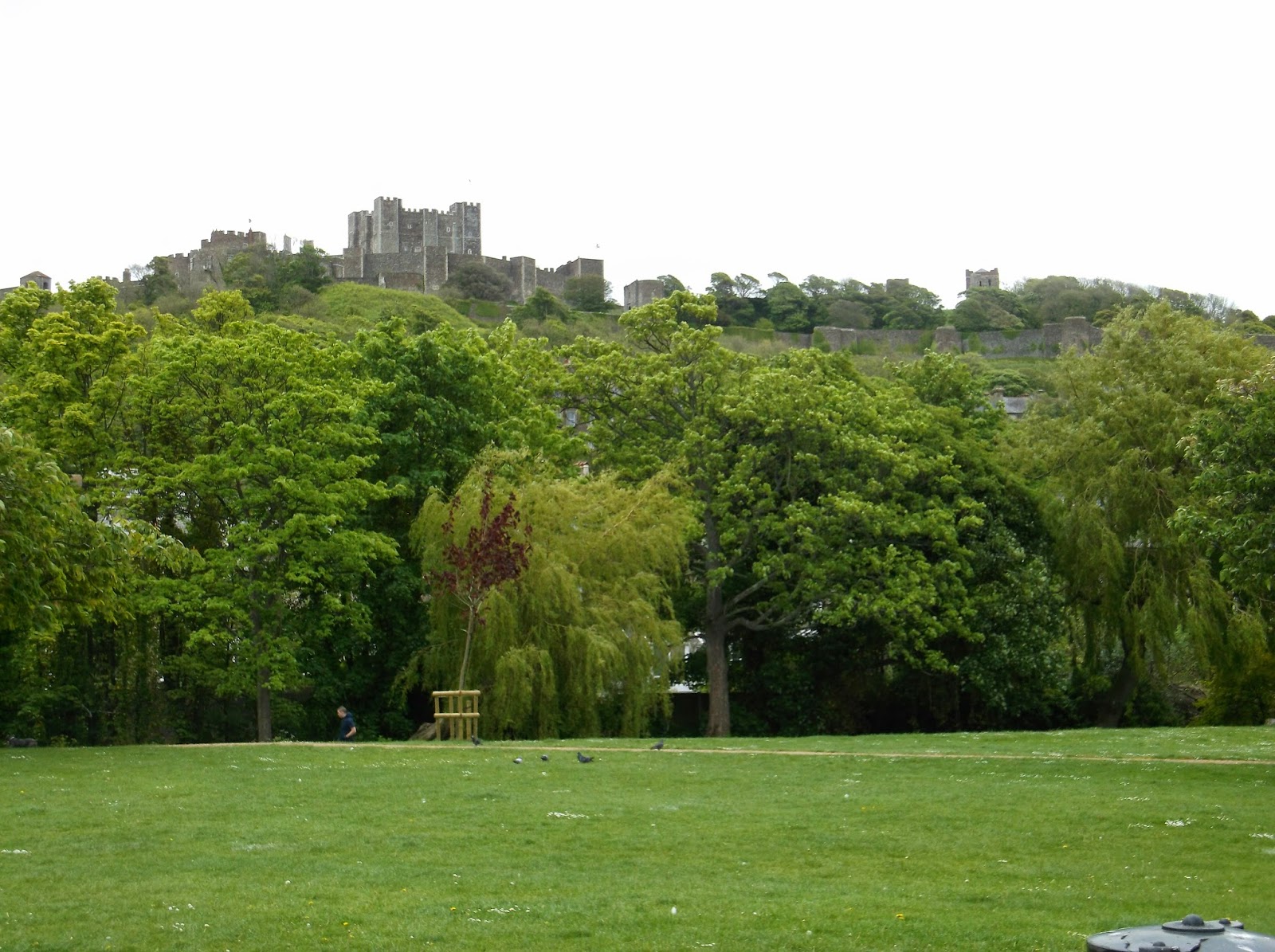

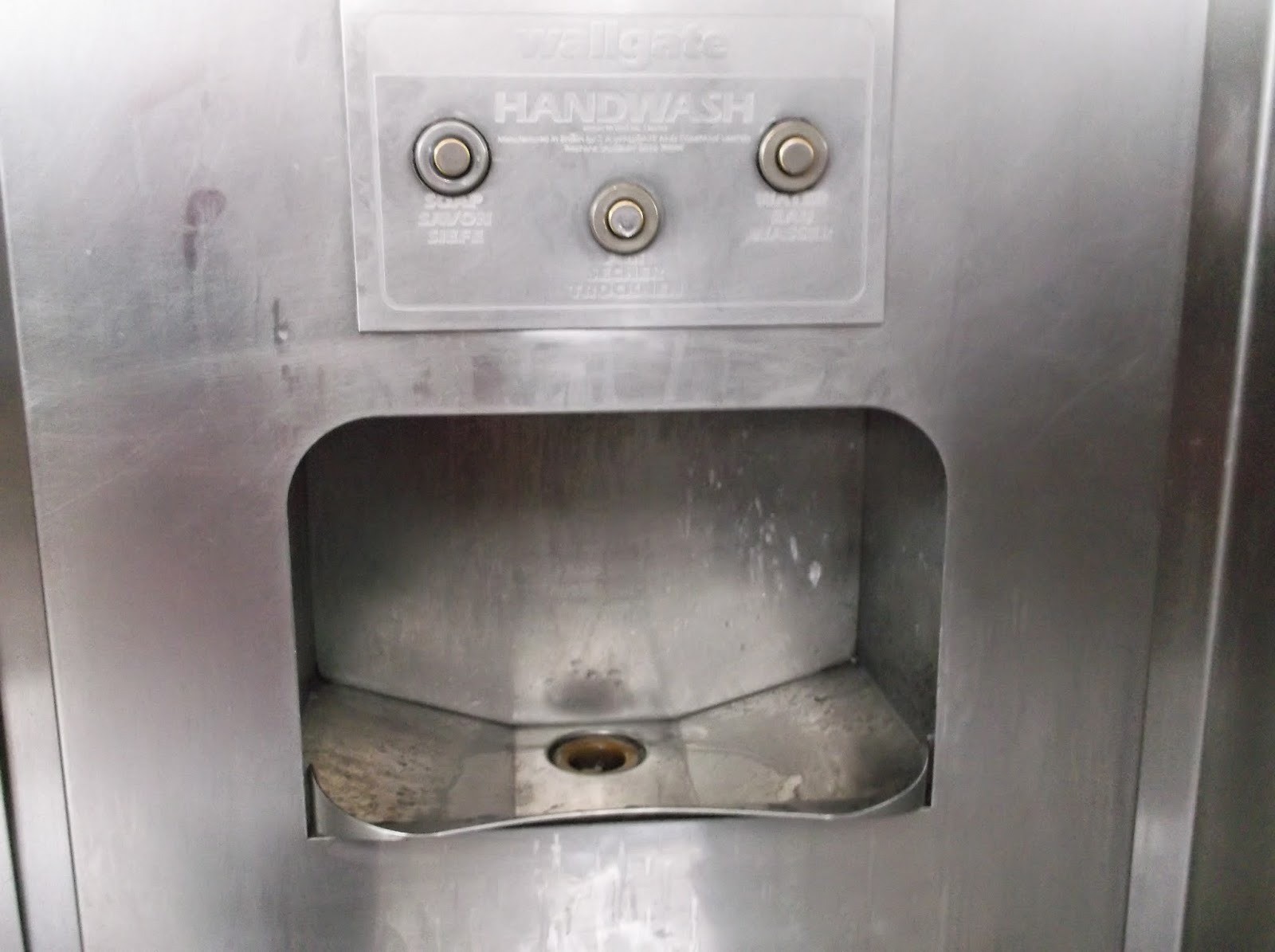
























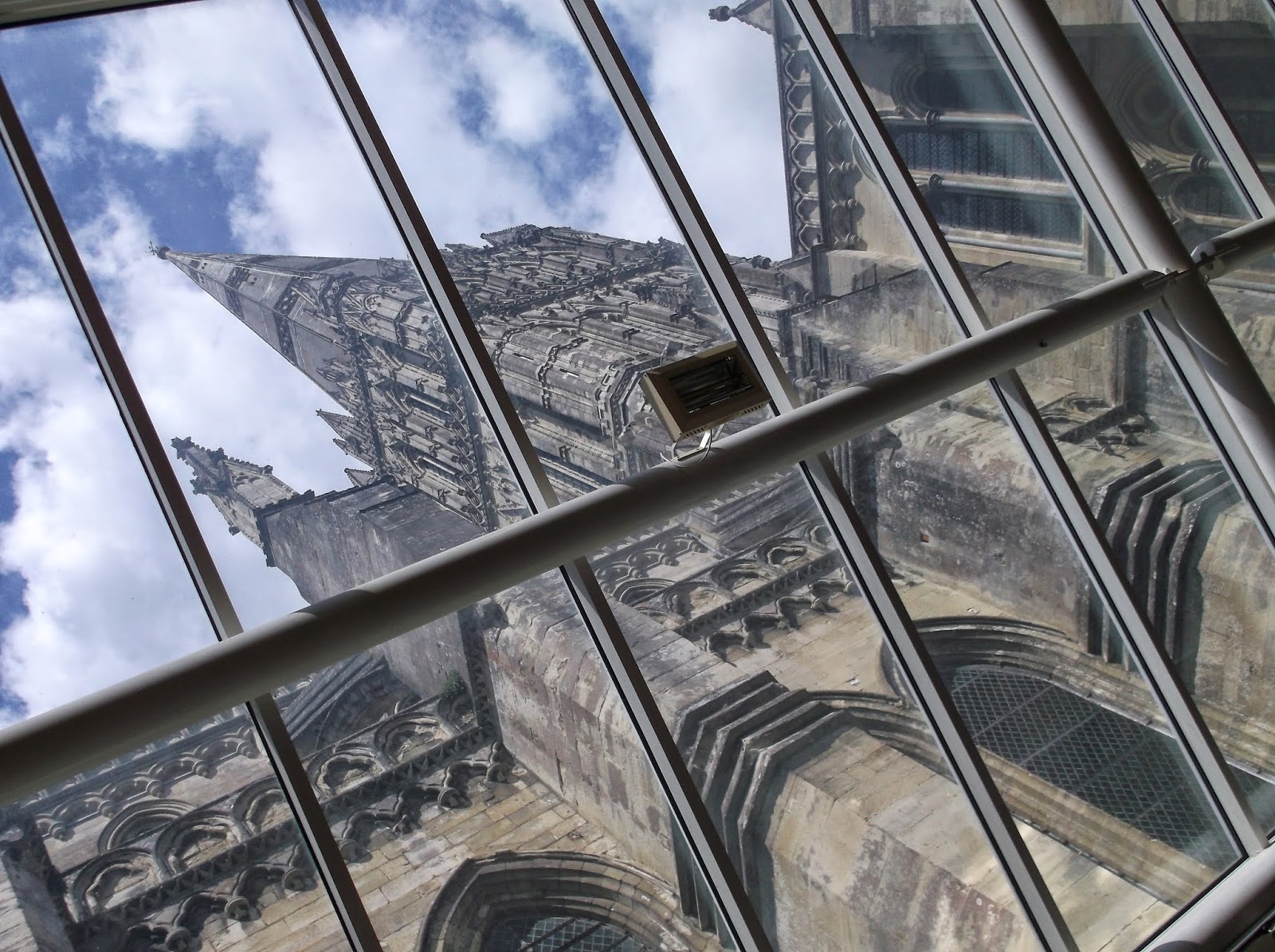


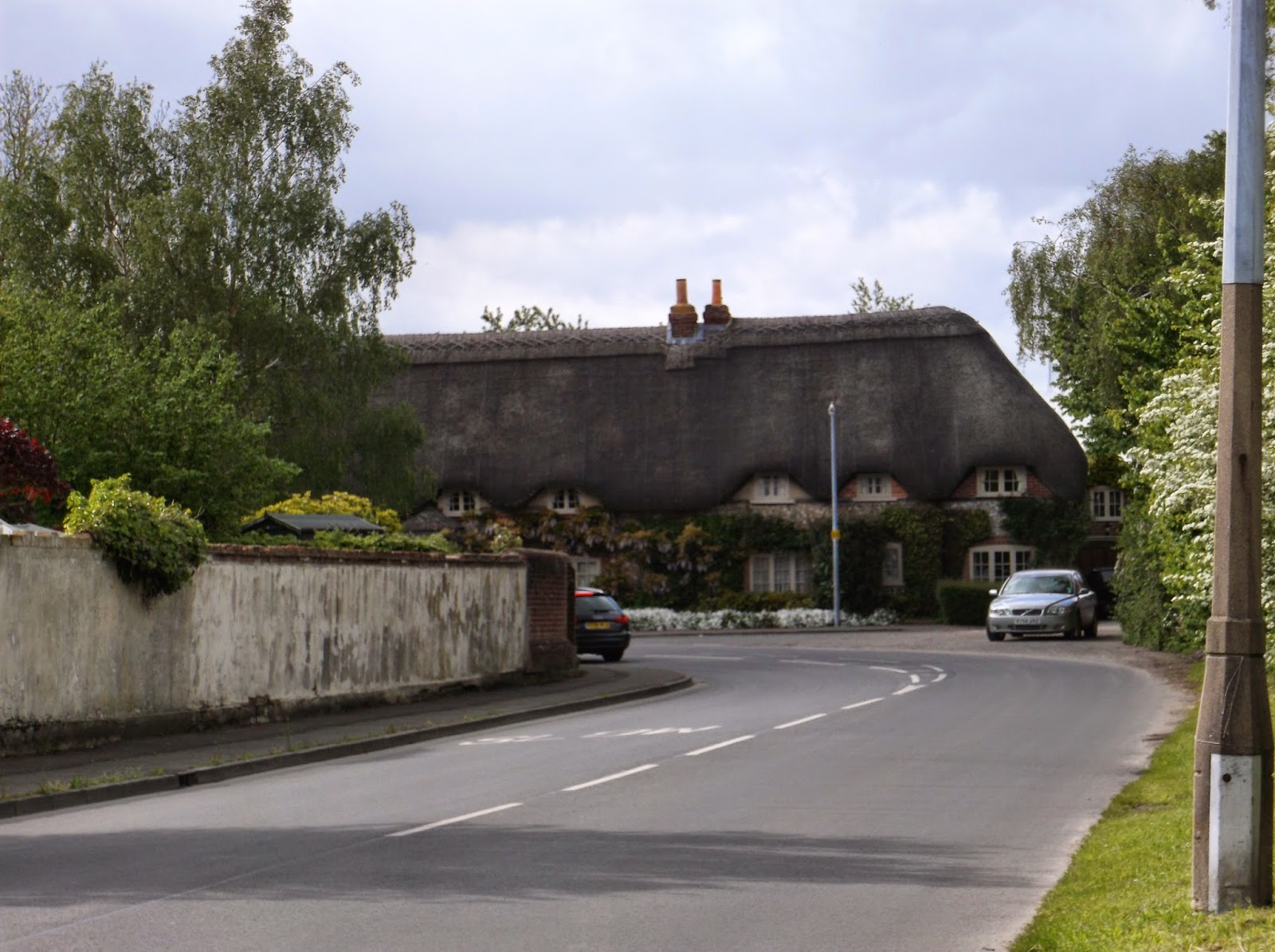







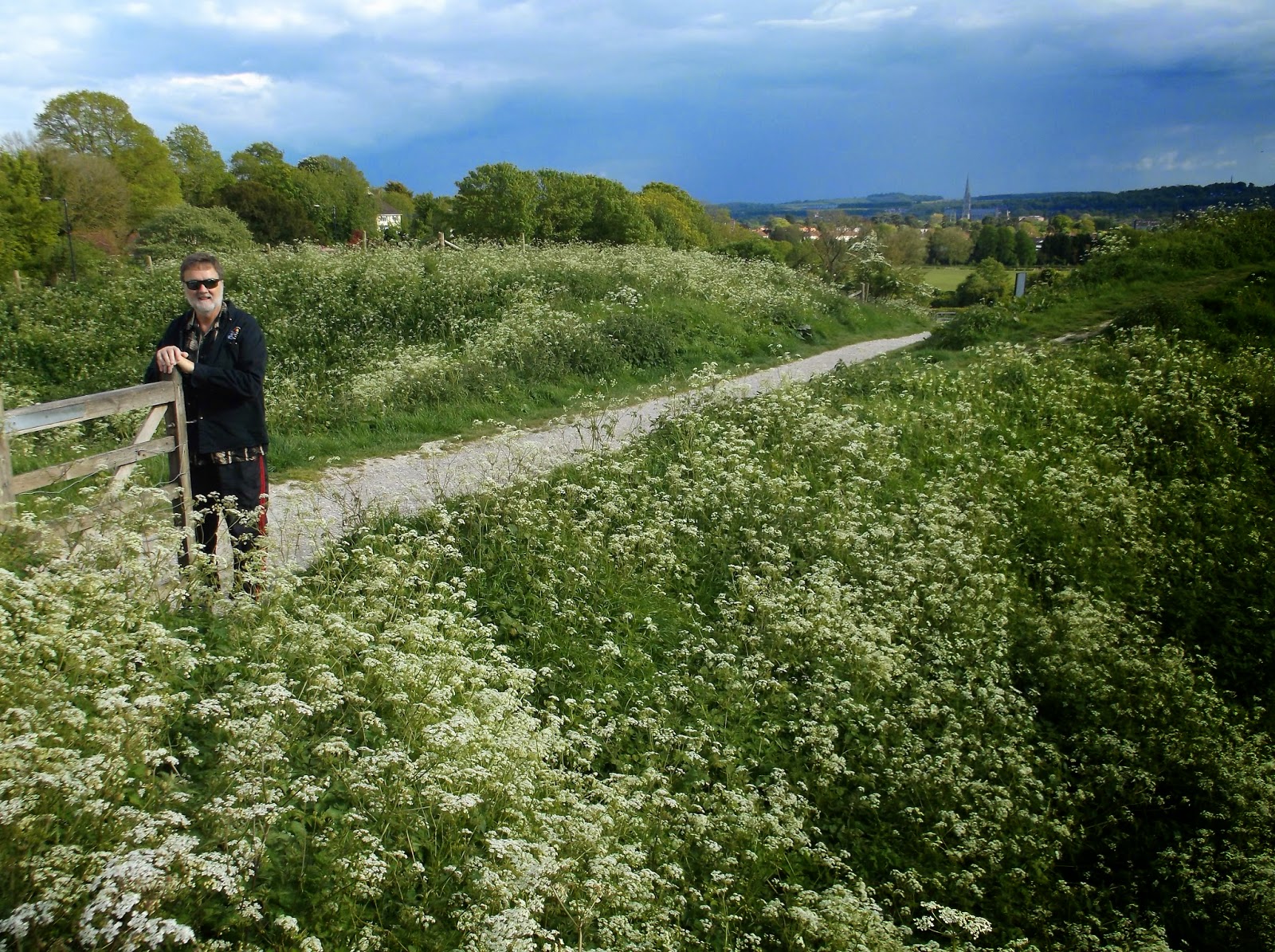
























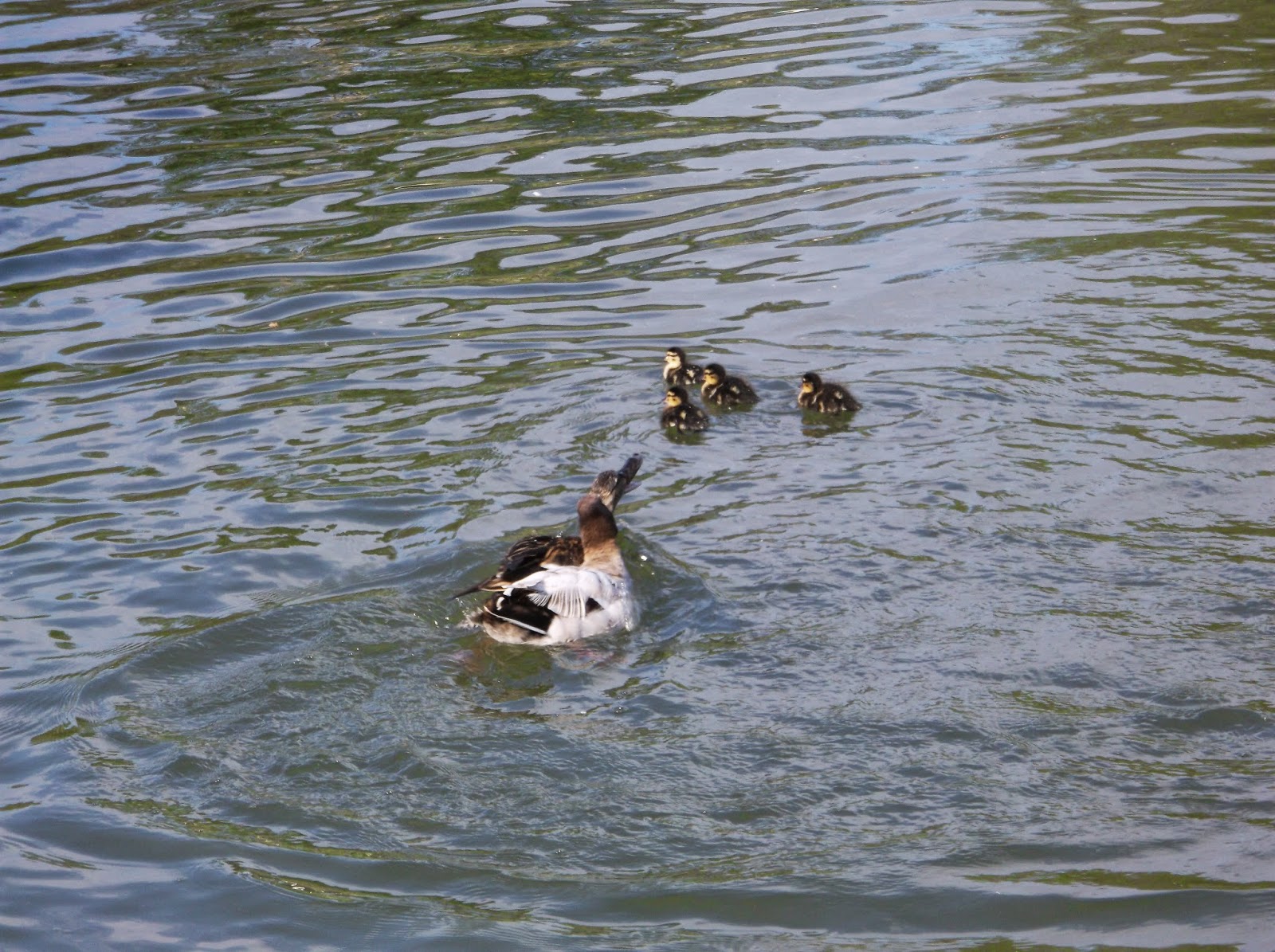

No comments:
Post a Comment